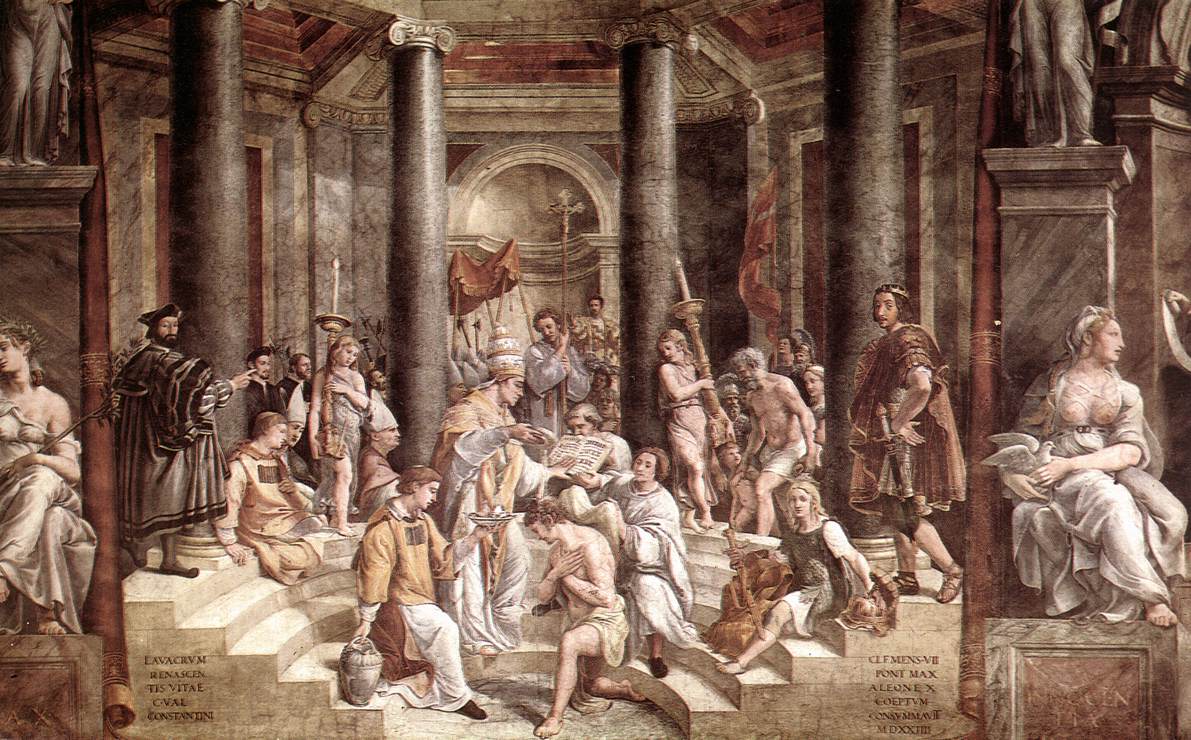The Baptism of Constantine
- The Baptism of Constantine
Painting_150px|

dim=300px
title=The Baptism of Constantine
artist=Gianfrancesco Penni
year=1517-1524
type=fresco
height=?
width=?
city=Vatican City
museum=Apostolic Palace
"The Baptism of Constantine" is a painting by assistants of the Italian renaissance artist Raphael. It was most likely painted by Gianfrancesco Penni, between 1517 and 1524.
After the master's death in 1520, Penni worked together with other members of Raphael's workshop to finish the commission to decorate with frescoes the rooms that are now known as the Stanze di Raffaello, in the Apostolic Palace in the Vatican. "The Baptism of Constantine" is located in the "Sala di Costantino" ("Hall of Constantine"). In the painting emperor Constantine I is seen shortly before his death, kneeling down to receive the sacrament from Pope Sylvester I in the Baptistery of the Lateran. The painter has given Sylvester the traits of Clement VII, the Pope who had ordered the frescoes to be finished, after the work was interrupted during the papacy of Hadrian VI.
While attempting the control and serenity typical of the High Renaissance, the crowded scene demonstrates the Mannerist tendency towards complexity and discordance.
Wikimedia Foundation.
2010.
Look at other dictionaries:
The Vatican — The Vatican † Catholic Encyclopedia ► The Vatican This subject will be treated under the following heads: I. Introduction; II. Architectural History of the Vatican Palace; III. Description of the Palace; IV. Description of the… … Catholic encyclopedia
Constantine the Great — This article is about Constantine as an Emperor. For Constantine as a Saint, see Constantine I and Christianity. Constantine I redirects here. For other uses, see Constantine I (disambiguation). Constantine I 57th Emperor of the Roman Empire … Wikipedia
Constantine the Great — • Information on the Roman emperor Catholic Encyclopedia. Kevin Knight. 2006. Constantine the Great Constantine the Great † … Catholic encyclopedia
Constantine the Great and Christianity — Constantine the Great Mosaic in Hagia Sophia, Constantinople, c. 1000 Isapostolos, 13th Apostle Born Feb 27, 272 in Naissus, Roman Empire (now … Wikipedia
The Byzantine Empire — The Byzantine Empire † Catholic Encyclopedia ► The Byzantine Empire The ancient Roman Empire having been divided into two parts, an Eastern and a Western, the Eastern remained subject to successors of Constantine, whose capital was at … Catholic encyclopedia
Constantine Chrysomalus — (or Constantine Chrysomallus; Greek: Κωνσταντῖνος Χρυσόμαλλος) was a Byzantine monk who was posthumously condemned by a Synod of Constantinople as a teacher of heresies affiliated with Bogomilism and Messalianism. Although Chrysomalus and his… … Wikipedia
The Rite of Constantinople (Byzantine Rite) — The Rite of Constantinople † Catholic Encyclopedia ► The Rite of Constantinople (Also BYZANTINE RITE.) The Liturgies, Divine Office, forms for the administration of sacraments and for various blessings, sacramentals, and exorcisms … Catholic encyclopedia
The History of the True Cross — The Dream of Constantine, the first nocturnal scene in Western art (pre restoration image) … Wikipedia
The Jesus Mysteries — The cover of The Jesus Mysteries features a gem of Dionysus/Orpheus … Wikipedia
The Renaissance — The Renaissance † Catholic Encyclopedia ► The Renaissance The Renaissance may be considered in a general or a particular sense, as (1) the achievements of what is termed the modern spirit in opposition to the spirit which… … Catholic encyclopedia

